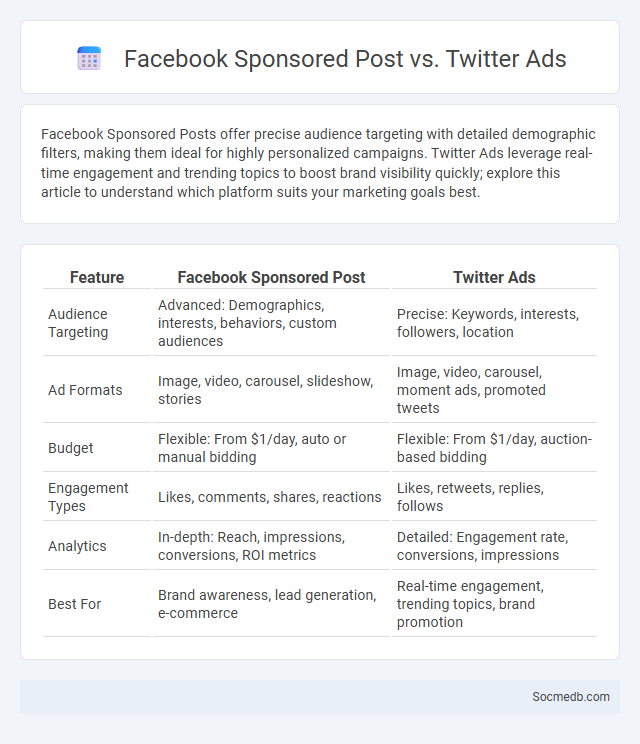
Photo illustration: Facebook Sponsored Post vs Twitter Ads
Facebook Sponsored Posts offer precise audience targeting with detailed demographic filters, making them ideal for highly personalized campaigns. Twitter Ads leverage real-time engagement and trending topics to boost brand visibility quickly; explore this article to understand which platform suits your marketing goals best.
Table of Comparison
| Feature | Facebook Sponsored Post | Twitter Ads |
|---|---|---|
| Audience Targeting | Advanced: Demographics, interests, behaviors, custom audiences | Precise: Keywords, interests, followers, location |
| Ad Formats | Image, video, carousel, slideshow, stories | Image, video, carousel, moment ads, promoted tweets |
| Budget | Flexible: From $1/day, auto or manual bidding | Flexible: From $1/day, auction-based bidding |
| Engagement Types | Likes, comments, shares, reactions | Likes, retweets, replies, follows |
| Analytics | In-depth: Reach, impressions, conversions, ROI metrics | Detailed: Engagement rate, conversions, impressions |
| Best For | Brand awareness, lead generation, e-commerce | Real-time engagement, trending topics, brand promotion |
Overview: Understanding Sponsored Posts vs Social Media Ads
Sponsored posts and social media ads are key components of digital marketing strategies, designed to increase brand visibility and engagement. Sponsored posts appear as organic content shared by influencers or users but are paid promotions, blending seamlessly into users' feeds to build trust and authenticity. Social media ads, on the other hand, are explicitly marked advertisements created by brands targeting specific demographics through advanced algorithms to maximize reach and conversion rates.
Platform Reach: Facebook vs Twitter Audience Demographics
Facebook boasts over 2.9 billion monthly active users, making it the largest social media platform with a diverse audience spanning all age groups, particularly strong among users aged 25-54. Twitter, with approximately 450 million monthly active users, attracts a younger, more urban demographic, predominantly aged 18-29, skewing towards professionals, influencers, and news enthusiasts. Brands targeting broad, multi-generational engagement often prefer Facebook, while Twitter excels in real-time conversations and niche community interactions.
Ad Formats: Facebook Sponsored Posts vs Twitter Ad Types
Facebook Sponsored Posts leverage highly targeted algorithms to display native ads within users' news feeds, maximizing engagement through rich media options like videos, carousels, and slideshow ads. Twitter Ad Types include Promoted Tweets, Promoted Accounts, and Promoted Trends, each designed to boost visibility and interaction within real-time conversations, using concise messaging and hashtags. Both platforms utilize advanced targeting tools based on user behavior, demographics, and interests to optimize ad performance and ROI.
Cost Comparison: Pricing Models and ROI
Social media platforms offer diverse pricing models, including CPC (cost-per-click), CPM (cost-per-mille), and CPA (cost-per-acquisition), enabling advertisers to tailor budgets to campaign goals. Analyzing ROI involves comparing customer acquisition costs against generated revenue, with platforms like Facebook and Instagram often delivering high engagement rates at lower costs. Marketers benefit from leveraging analytics tools to monitor conversion rates and optimize ad spend for improved cost-effectiveness.
Targeting Capabilities: Precision & Customization
Social media platforms offer advanced targeting capabilities that allow you to precisely reach your ideal audience based on demographics, interests, behaviors, and location. Customization options enable tailoring of content and ads to match user preferences, increasing engagement and conversion rates. These precision tools empower marketers to optimize campaigns and maximize ROI effectively.
Engagement Rates: Which Platform Performs Better?
Engagement rates vary significantly across social media platforms, with Instagram typically outperforming Facebook and Twitter due to its visual-centric content and interactive features like Stories and Reels. TikTok shows remarkable engagement, especially among younger audiences, driven by its short-form, algorithmically curated videos that encourage user interaction. To maximize your social media strategy, analyzing platform-specific engagement metrics can help you determine which channel best connects with your target audience.
Creative Options: Content Styles and Visuals
Social media platforms thrive on diverse creative options, with content styles ranging from short-form videos and Stories to carousel posts and infographics, each optimized for engagement. Visuals play a crucial role, including high-resolution images, branded templates, and interactive graphics that capture attention and reinforce brand identity. Leveraging dynamic content formats like reels, live streams, and augmented reality filters enhances user interaction and drives higher reach across networks like Instagram, TikTok, and Facebook.
Analytics & Performance Tracking
Social media analytics and performance tracking empower you to measure the effectiveness of your campaigns through detailed metrics such as engagement rates, reach, and conversion tracking. By analyzing user behavior and content performance on platforms like Facebook, Instagram, and Twitter, you can optimize strategies to increase ROI and audience growth. Leveraging tools like Google Analytics, Sprout Social, or Hootsuite provides real-time data that drives informed decisions and enhances your social media marketing success.
Use Cases: Best Scenarios for Each Channel
Facebook excels in community building and targeted advertising, making it ideal for businesses aiming to engage diverse audiences and boost customer loyalty. Instagram's visual-centric platform suits brands focusing on lifestyle, fashion, and influencer marketing to inspire and attract followers with high-quality images and stories. LinkedIn is best for B2B networking, professional content sharing, and recruiting top talent, helping you establish authority and grow your professional connections.
Choosing the Right Platform for Your Campaign
Selecting the right social media platform for your campaign hinges on understanding your target audience's demographics and behaviors. Platforms like Instagram and TikTok excel with younger users through visual content, while LinkedIn caters to professionals for B2B marketing. Your campaign's success improves by aligning content style and platform strengths with your marketing goals.
 socmedb.com
socmedb.com